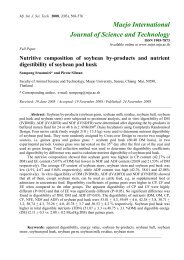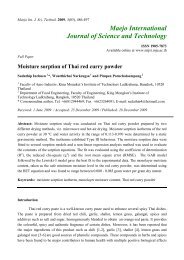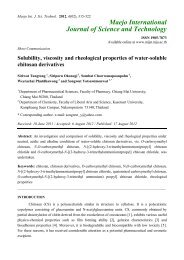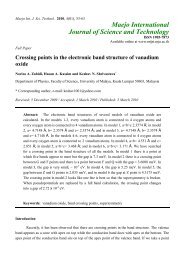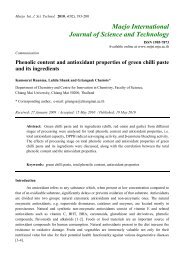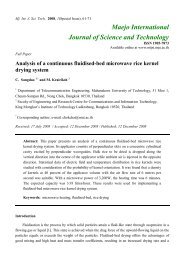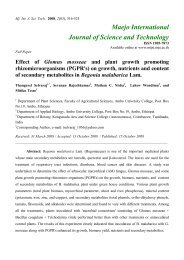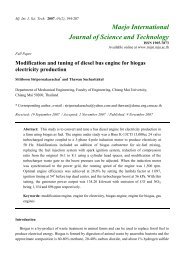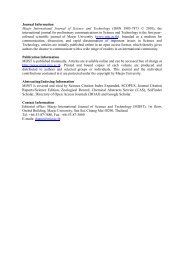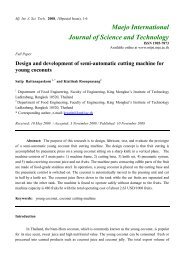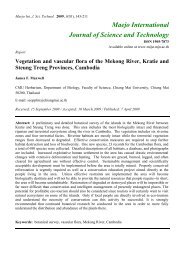ISSN 1905-7873 © 2012 - Maejo International Journal of Science ...
ISSN 1905-7873 © 2012 - Maejo International Journal of Science ...
ISSN 1905-7873 © 2012 - Maejo International Journal of Science ...
You also want an ePaper? Increase the reach of your titles
YUMPU automatically turns print PDFs into web optimized ePapers that Google loves.
4 <strong>Maejo</strong> Int. J. Sci. Technol. <strong>2012</strong>, 6(01), 1-11<br />
Table 1. Carotenoid and chlorophyll content <strong>of</strong> Cladophora sp. (Kai) cultured at different phosphate<br />
concentrations<br />
Amount <strong>of</strong> pigments (g g -1 dry weight)<br />
Pigment<br />
Control Treatment 1 Treatment 2 Treatment 3 Treatment 4<br />
K 2HPO 4(mgL -1 )= 0 K 2HPO 4(mgL -1 )= 5 K 2HPO 4(mgL -1 )= 10 K 2HPO 4(mgL -1 )= 15 K 2HPO 4(mgL -1 )= 20<br />
Total carotenoid 889±157 a 1,084±253 a 1,130±147 a 1,151±151 a 1,729±212 b<br />
Carotene 44±4 a 86±9 b 87±6 b 96±7 bc 103±9 c<br />
Xanthophyll 779±42 a 997±254 a 1043±145 a 1055±154 a 1626±220 b<br />
Chlorophyll a 148±13 a 270±30 b 309±20 bc 305±52 bc 348±17 c<br />
Chlorophyll b 56±31 a 173±11 b 245±15 bc 200±49 c 249±16 c<br />
Note: Each value is mean ± SD<br />
Data in the same row with different superscripts are significantly different (p0.05).<br />
Carotenoids in green algae are produced in two different compartments and by two different<br />
pathways, i.e. the acetate-mevalonate pathway and the phosphoglyceraldehyde-pyruvate pathway,<br />
and they are further synthesised from isopentenyl diphosphate and its isomers [42-43]. In the present<br />
study it was observed that phosphate increased carotenoid and chlorophyll production in the alga,<br />
which agrees with the findings by Khuantrairong and Traichaiyaporn [4-5] that total carotenoid, β-<br />
carotene, lutein and zeaxanthin in Cladophora sp. positively correlate with phosphate level. Celekli<br />
et al. [29] reported that the phosphate supply increased biomass and carotenoid production in a bluegreen<br />
alga (Spirulina platensis) while Latasa and Berdalet [25] deserved that the synthesis <strong>of</strong><br />
pigments in a din<strong>of</strong>lagellate Heterocapsa sp. stopped upon phosphorus limitation. In contrast,<br />
Buapet et al. [30] suggested that phosphorus enrichment had no significant effect on chlorophyll a<br />
production by Ulva reticulate seaweed. Subudhi and Singh [35] reported that a high concentration<br />
<strong>of</strong> phosphate-phosphorus reduced the chlorophyll content <strong>of</strong> Azolla pinnata blue-green alga.<br />
Enhancement <strong>of</strong> astaxanthin in a green alga (Haematococcus pluvialis) [31,34] and that <strong>of</strong> β-<br />
carotene, zeaxanthin and violaxanthin in a marine microalga (Nannochloropsis gaditana) [33] were<br />
observed upon phosphorus limitation. Leonardos and Geider [32] stated that the nitrate-tophosphate<br />
supply ratio was related to carotenoid and chlorophyll-a production in the cryptophyte<br />
Rhinomonas reticulata.<br />
Biomass Production<br />
For 12-week cultures, the biomass production was similar among the treatments and ranged<br />
between 3,406-3,464 g m -2 (wet weight) (Figure 1). The highest value, 4,167 g m -2 , was observed in<br />
treatment 3 after culturing for 10 weeks. However, statistical analysis indicated that Cladophora sp.<br />
(Kai) cultured at different phosphorus concentrations showed no significant difference in growth<br />
(p>0.05).<br />
The specific growth rate (SGR) was similar among treatments and ranged between -2.7 _<br />
38.9% d -1 . After one week <strong>of</strong> cultivation, the alga began to grow quickly and the highest SGR values




